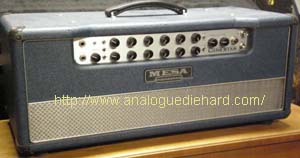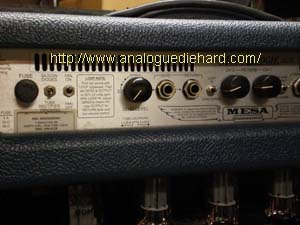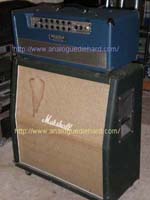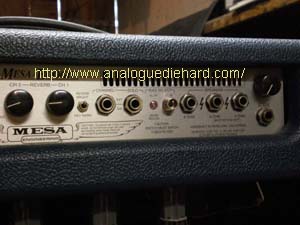Mesa Boogie Lonestar tube guitar amplifier
Last Update 12/09/2017
The Lonestar was an amp I long overlooked because I had
stereotyped Mesa Boogie with the "high gain" sound which I no longer
wanted. When our southern rock band was playing a showcase, we
elected to use the backline drums, keyboards, and guitar amps belonging
to the host
band of the club. Since we were only playing four songs, this was
reasonable. Mindful that my Telecaster and
Les
Paul
were voiced
for my own guitar amp
modeller, I elected to use my Stratocaster
for
the
showcase as it would be better equipped for whatever amp I was using,
which was unknown. I was given use of the rhythm player's
Lonestar amp and
the sound of the amp surprised me - it wasn't the atypical Mesa Boogie
high gain sound, but actually fit into the southern rock genre we were
playing. And it sounded pretty good with my Strat.
So some research revealed that in a radical departure for Mesa Boogie,
the Lonestar amps were designed to appeal to Texas Blues players.
There was a Mesa Boogie authorized dealer near me so I took my Strat to
audition the amp. I tried the amp in the store... and didn't like
the tone at all.
It didn't sound like the amp I had used at the showcase. It was a
combo 2x12 amp. By then I had knowledge of different speakers
associated with different genres, and had a selection of them in my
project studio. I knew that the Celestion "greenback" speakers
was THE sound of southern rock. A quick peek revealed that the
internal speakers could be disconnected. The store was also an
authorized Marshall amp dealer so I hunted through the Marshall
cabinets they had in stock. One of the 4x12 cabinets was rated
for
"100 watts" - that told me it was loaded with "greenback" speakers
which are rated for 25w apiece, so four of them in a 4x12 cabinet is a
100w cabinet (c'mon the math isn't THAT hard). Thankfully it had
the new speaker jack panel offering stereo 8 ohm or mono 4 or 16 ohm
configurations; the Lonestar amp did not have a tap for 16 ohm
impedance but it did have a 4 ohm tap so it was safe to use the
Marshall cabinet.
Those speakers made a WORLD of difference. NOW I was hearing the
amp I heard at the showcase. One of my goals was to reduce my
cartage down
to one guitar - I had songs I needed the Telecaster
because the Les Paul was just too thick sounding. My Strat with
the
humbucker in the bridge position and single coils in the others could
get both tones, but not the southern rock tones through
my modeller. For the time being I had to switch guitars,
sometimes in the middle of them. Running through the songs we
were
playing in the southern rock band, I concluded that the Strat by itself
could nail all the sounds I was using...
...and not much later I decided to leave the band at the end of the
year for reasons which I won't go into. With me leaving the band,
I didn't have an immediate need for the Lonestar amp and had forgotten
about it. A little over a year later I started thinking about the
amp again, and a quick peek on eBay uncovered two used Lonestar heads
selling for a reasonable price. I would had preferred the head as
the combo package not only was rather heavy but I did NOT want the
stock speakers that came with them. One of the heads revealed
severe rust on the screws so I opted for the other one. As is
typical of purchases made on the 'bay, this amp needed some TLC so I
took it to my authorized Mesa Boogie amp tech for restoration back to
stock. Armed with the knowledge that these amps could be fitted
with 6L6 or EL34 power tubes, I requested a set of matched EL34 tubes
as I
was aiming for the sound of my Marshall amp and not the
Fender sound.
The Lonestar is a true two channel amp, each not only having its own
set of controls (gain, presence, treble, middle, bass, master, reverb,
AND power amp rating) but each has a different architecture for dirty
vs clean
channel. One tube power amp is shared between them, which turned
out to be an acceptable compromise because each channel can be set to
100w, 50w, or 10w power. On earlier Lonestar amps (like the one I
bought) only 100w and 50w power are available. The two channels
are switchable via a footswitch. The dirty channel is indeed
voiced like a 1970s Marshall, and a cascade option is available (with
independent DRIVE control) adding another triode for high gain sounds
(not quite the high gain sound associated with metal and grunge
bands). With independent control of each triode with DRIVE and
GAIN, you can vary the tone to optimize your lead playing. Sadly
the high gain option can't be switched in via a footswitch. There
is a three way switch to vary the tone between normal, thick, and
thicker.
The clean channel is voiced like a blackface Fender amp of the 60s,
before CBS acquired Fender Instruments and proceeded to make prettier
guitars and amps (I'm being nice as everybody knows how well that
DIDN'T turn out). It has that unique blackface slight glassy dirt
and that bluesy tone with a neck pickup. The GAIN control has
enough range where you could get the clean channel to distort.
Rounding out the front panel is the Output and Solo controls, the
former being the Master Volume for the whole package and the latter a
handy boost for solo playing. The power switch include a "tweed"
position, which provides a "brown out" lower voltage to the plates of
the tubes for a distortion earlier and responds differently.
Couple this with the tube rectifier switch on the rear of the amp and
you get that "old school" sound where rectifier tubes impart a unique
spongy compression on the sound. I like
these two features a lot, which happen to be in the vintage Fender
tweed amp that I own. One other benefit of the "tweed"
setting is it will lengthen the life of the tubes since they are not
stressed as hard. Diode rectifiers can be used for bolder and
tighter sounds; If either channel is set to 100w power, diode
rectifiers are automatically engaged for proper matching to the load on
the power supply.
On the rear panel you can set the reverb levels for each channel, a nice feature.
A mini toggle switch selects the tone of the reverb between bright and
warm. The reverb can be switched on/off via a footswitch.
Effects loop with associated send level control and switch for hard
wired bypass is a standard feature on modern tube amps these
days. Two external switch controls for channel switching and solo
are provided for MIDI control accessories that provide a logic switch
output. My favorite feature is the power tubes. The
Lonestar can be used with 6L6 or EL34 power tubes. The mini
toggle switch MUST be set to the tubes in use for the correct
bias. You can even use 6V6 power tubes in place of the 6L6 tubes
for closer approximation to the Fender sound, but you have to use the
100w power setting in the channel and the "tweed" power switch position
or it will damage the tubes and the amp. 6V6 tubes will distort
sooner and sound different, but will also have a lower output power.
Probably my least favorite option - not a dealkiller - is the lack of a
16 ohm speaker tap. I prefer Marshall speaker cabinets which are
16 ohms, and I had to install a replacement speaker jack switch system
that allowed me to use a Marshall cabinet at 4 ohm configuration that
the Lonestar was happy with. It would had been safe to use a 16
ohm cabinet in the 8 ohm tap on the amp, but at the expense of some
tone. Some players and studio owners believe that the 16 ohm
configuration has a better sound but I'm not fully convinced of this.
Whew...! A lot of features for a guitar amp, but the flexibility
is worth it. Might be pretty overwhelming for the conservative
guitar player who can't comprehend anything more complex than volume
and tone controls on their guitars, and it is not as frustrating as
getting the optimal gain staging between rhythm and lead channels on a
Mesa Boogie Mark amplifier. Indeed, the Lonestar appears in a lot
of touring acts and has found a home in country and blues bands.
With all those features, the head package is quite heavy. Mesa
Boogie built speaker enclosures with 1x12 or 2x12, so you will see
narrow and wide heads to fir the form of the cabinets. Mesa
Boogie also offered custom covering, as a quick Google on image will
reveal the rainbow of Lonestar amps out there.
All of my guitars sound good through the Lonestar, and in my opinion
the Lonestar sounds great through a Marshall 4x12 loaded with
"greenback" 25w Celestion speakers. I liked the Strat through the
amp, but have found that the Les Paul is even better. It really
approximates the Marshall tone in the dirty channel, and I actually
found a setting in the clean channel where the LP isn't so thick - and
can even approximate the bluesy Jimi Hendrix/Stevie Ray Vaungh sound on
the neck pickup. The Lonestar is the most versatile non-modeling
amp in my arsenal.
Is the Marshall redundant? Happily it isn't, as there are some
things that the Lonestar can't do. It doesn't have the dynamic
timbre range of my modified Marshall where I can swing between
balls-to-the-walls crunch and sweet clean tone just by how hard I am
striking the strings. The Lonestar doesn't have the same
articulation with muted and "chicken" picking. And lastly, the
Lonestar doesn't feedback like the Marshall does.
Yes I know the tone controls in the pictures are not correct.
You'll have to figure out your own settings, gosh darn it.

Home










